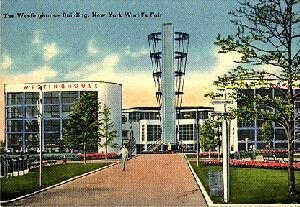|
1 2 3 |
 Copyright: |
On the one hand the New York World Fair offered the traditional form of a world exhibition – a display of the latest industrial goods explaining the function of products with wall charts and fotos; on the other hand the New York fair was marked by spectacular productions staged by the corporate giants. Technology was celebrated as the magic means to bring forth a happy future: Robots and remote control devices were to free people from their daily chores.
First steps towards a technologically dominated future were made in the communications sector. At the New York fair a new means of mass communication was born: the company R.C.A. broadcasted the opening ceremony live on TV. Of course, that was limited to New York at first as they used transmitters on the Empire State Building. Moreover, only a few people could afford the then expensive TV sets, but on the site the TV screens were always besieged by visitors. Another machine indispensable today was introduced to a wider public as well in 1939: the fax machine.
Hardly an industry had developed as explosively in recent decades as the electrical industry. In the pavilion of the electrical corporation Westinghouse, elegantly covered with a glass façade, two innovative exhibits were shown. In the centre of the pavilion stood the Singing Tower of Light that was to excite the visitors’ interest for the Hall of Electric Power and the Hall of Electric life. The second attraction at Westinghouse was a time capsule that was buried in a 15 metres deep tomb. Filled with objects of daily life, product samples, books, coins and micro fiches, the capsule was to be opened after 5000 years – in the year 6039.
The second industry to leave its stamp on this century, the automobile industry, was not less impressively represented in New York. The big three – General Motors, Chrysler, Ford – built the largest pavilions. The head designer of General Motors, Norman Bell Geddes, expressed their motto: “Today, speed is the cry of our era.” The era of railroads was already over in the States, air traffic was still in its infancy, therefore the car embodied ideally the American dream of unhindered mobility.
Henry Ford himself had the idea for the company’s pavilion – as in Chicago six years ago. Visitors queued to test drive the latest models on a spiral called the ‘Street of Future’. Inside the Ford production cycle could be viewed on a cone-shaped revolving stage weighing 150 tons. Small-scale models with moving puppets showed the production of a Ford car, starting with the extraction of raw materials to the finished product placed at the top of the cone.
| Year: 1939 | City: New York | Country: USA |
| Duration: 30th April - 31st October 1939 und 11th | ||